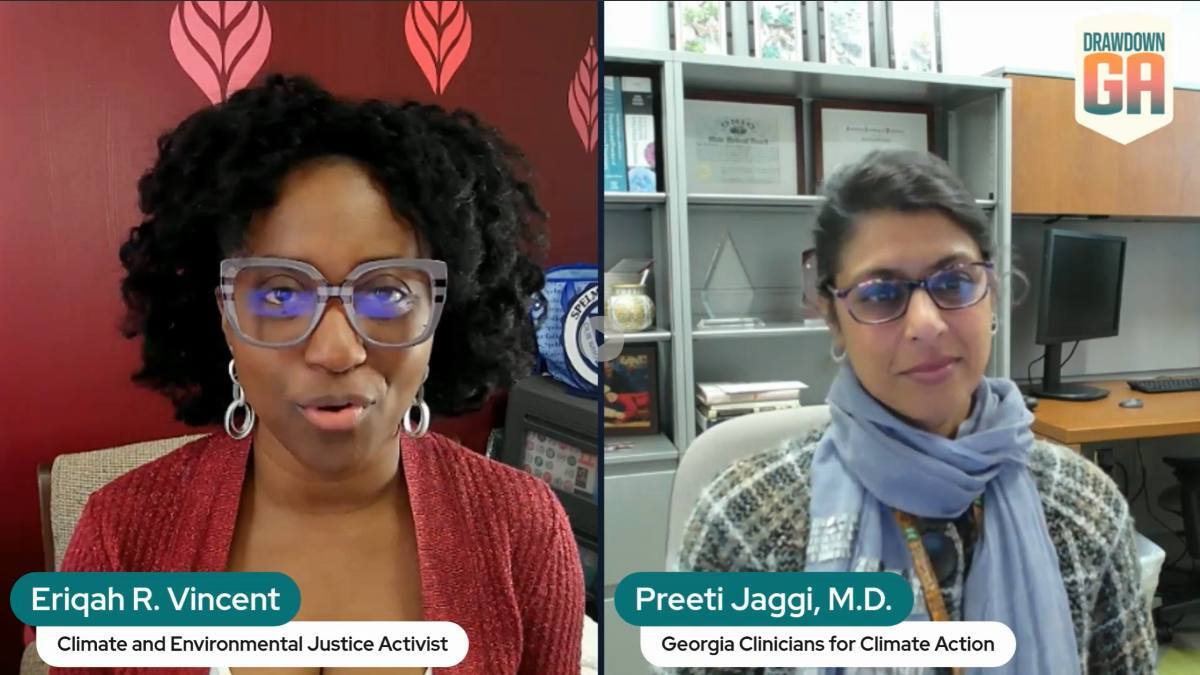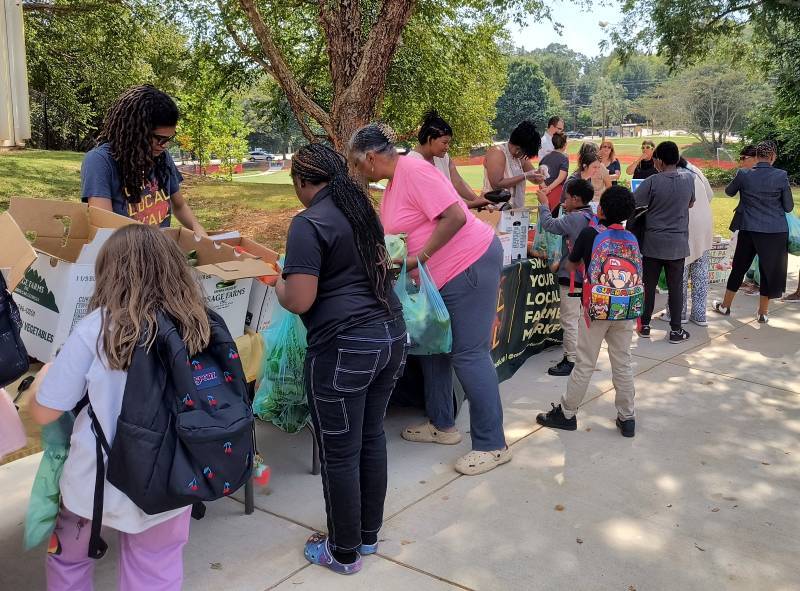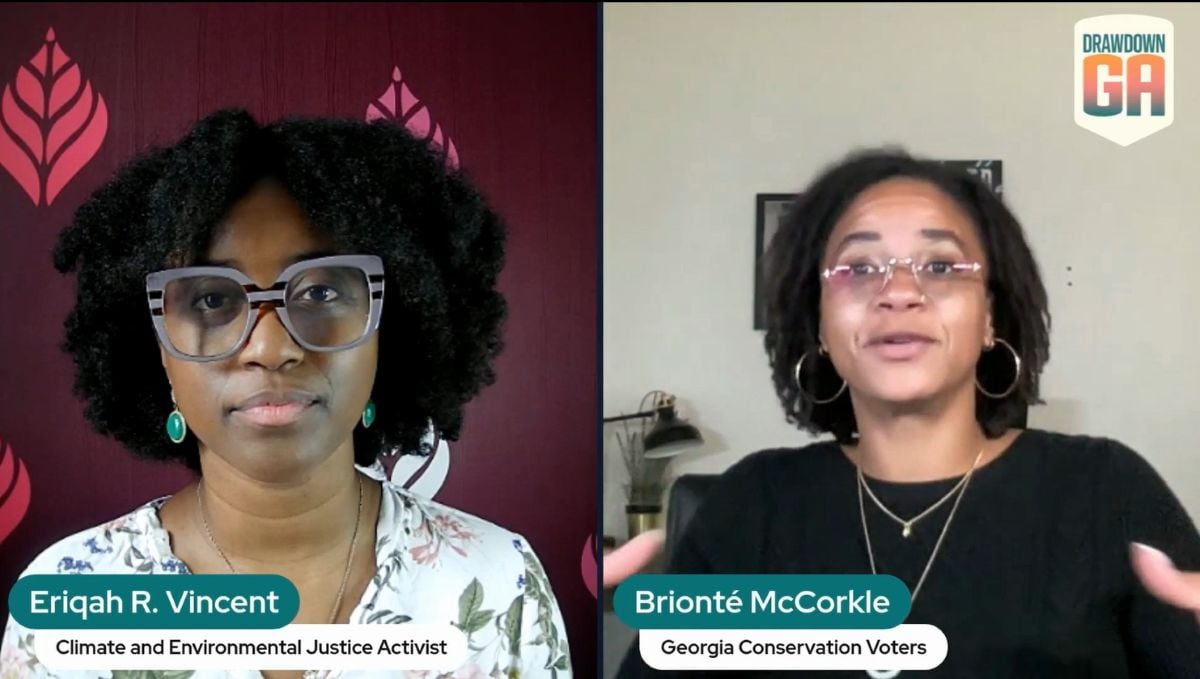In an ideal world, affordable and healthy local food would be available to everyone across Georgia and the US. The reality is starkly different, as local, sustainable food options are often the most expensive or inaccessible, with lasting consequences for the Earth and human health.
At the same time, a significant portion of the food we produce is wasted, ending up in landfills instead of nourishing people. This food also contributes to greenhouse gas emissions and missed opportunities to support communities facing food insecurity.
Reduced food waste is one of the 20 Drawdown Georgia climate solutions, and now, new efforts across the state are working to build local food systems that tackle food waste and improve food access, with a focus on the communities that feel the strain of food insecurity the most.
The High Cost of Healthy Food, and Who Pays the Price
Why is local food so expensive in the first place? The biggest factor lies in the industrial grocery system, which prioritizes large-scale production and uniformity. Local food grown with a minimal carbon footprint can often face barriers to entry in large grocery stores because of small production scale and aesthetic standards, which in turn reduces the number of locations where you can find local food options. Where they can be found, local food options often come with a higher price tag to help make up for some of those barriers to entry.
The scarcity of these local and healthy foods means that they are often overlooked in favor of cheaper or more accessible alternatives, especially in places that are already suffering from a lack of grocery accessibility. Additionally, nearly one in seven people in Georgia is food insecure.
For families who may be facing food insecurity or living in a food desert, they may not have the extra money to buy local produce or other healthy food options, or the time to seek them out and prepare them at home. When families can’t access or afford nutritious meals, they often rely on calorie-dense, ultra-processed foods. This can lead to a cycle of irregular eating patterns, stress eating, and nutritional deficiencies.
Over time, the toll becomes visible in the form of chronic illnesses such as cardiovascular disease, obesity, diabetes, and other metabolic disorders. These issues are particularly harmful during childhood, when early nutrition shapes long-term development.
And at the same time that American families are in need, millions of pounds of food is going to waste, much of it fresh fruits and vegetables.
Food Waste and Health: A Shared Crisis
Food waste is one of the biggest sources of landfill waste and carbon emissions today. In Georgia, food waste is the single largest category of solid waste going to landfill, and the Atlanta metro area accounts for 48% of that food waste alone. Across the U.S., 78 million tons of food are wasted each year, accounting for 58% of landfill methane emissions. Often, this waste results from perfectly edible and healthy food being discarded.
The impacts of food waste go beyond the landfill and are also deeply connected to public health.
Food waste is intricately connected to public health in several significant ways:
1. Exacerbating Food Insecurity
When large amounts of edible food are lost or wasted, fewer nutritious resources are available to those facing food insecurity. This paradox—food being discarded while millions are hungry—worsens public health outcomes by contributing to undernutrition and its related diseases. Redistributing wasted but edible food could directly alleviate hunger and related health disparities.
2. Nutrient Losses and Diet Quality
Much of the food wasted—especially fruits, vegetables, dairy, and meats—contains vital nutrients. When these foods are discarded, the population's overall diet quality may suffer, leading to micronutrient deficiencies and increased risk of chronic illnesses like obesity, diabetes, and cardiovascular diseases.
3. Health Risks from Food Waste Disposal
Improperly managed food waste can create public health hazards through:
-
Emission of harmful gases
, including ammonia, hydrogen sulfide, and volatile organic compounds. Chronic exposure to these can irritate respiratory systems, disrupt endocrine and nervous system function, and even increase cancer risk, especially for waste workers and people living near waste disposal sites. -
Accumulation of organic matter that attracts vermin and pathogens, increasing the spread of infectious diseases.
-
Environmental impacts that indirectly affect health, such as greenhouse gas emissions contributing to climate change, can further drive food insecurity and increase the prevalence of certain diseases.
The problem is clear, but when we work to improve our food system and ensure that nutritious food reaches those who need it (and stays out of the trash), these actions also benefit climate and public health in so many ways.
Solutions Rooted in Community Innovation
Fortunately, many Georgia companies and consumers are stepping up to address these pressing issues. New grocery models and food recovery initiatives are proving that it is possible to provide affordable, healthy food while reducing waste and supporting local economies.
Some supermarkets are taking major steps to curb food waste by being more transparent and adopting actionable policies, such as Kroger’s Zero Hunger | Zero Waste Food Rescue program. At the same time, services like Too Good To Go now exist to reroute excess food—either directly to consumers at reduced prices or through nonprofit organizations that distribute it to families in need.
These systems are not only keeping food out of landfills but also increasing access to full, healthy meals across Georgia and reducing health risks for individuals.
Goodr Takes Action on Food Waste and Hunger
Another exciting example of these efforts comes from Goodr, an Atlanta-based company focused on reducing food waste and hunger. With the motto “Feed more, waste less”, Goodr helps businesses divert edible food waste from landfills by transporting it to nonprofits in food-insecure communities.
Goodr has also opened 29 school-based grocery stores and mobile markets with the goal of giving food-insecure families access to healthy meals in a stress-free and dignified shopping experience. Their newest project is the Goodr Community Market, a standalone store that offers even more opportunities.
The Goodr Community Market: A New Subsidized Grocery Store in Atlanta
The Goodr Community Market is located on Edgewood Avenue in the 30312 ZIP code, which is one of the most food-insecure ZIP codes in Atlanta. The market functions as a subsidized grocery store, providing locally-sourced grocery items at an affordable price.

The market also has a cohort of sponsored shoppers local to the surrounding neighborhood who shop for free once a month. Sponsored shoppers access this benefit with a program card that looks similar to the market’s loyalty program card to eliminate any stigma between sponsored shoppers and regular shoppers.
Just like many other large grocery stores, the community market has a deli, but this one is a little different. Customers can enjoy affordably priced $5 sandwiches from Little Loaf Deli, and discount programs for families and students.
The key to making this market work? Community. The market would not have been possible without the involvement of a multitude of local organizations that are committed to better Atlanta and Georgia:
-
Invest Atlanta, a city-run investment program that helps to subsidize the market
-
BeOnEdgewood, a community-building organization that has granted the storefront space for this market to exist
-
IGA (Independent Grocers Alliance), dedicated to supporting small grocers and connecting them with local producers, which helps shorten the supply chain and keep more dollars within the community
-
Wholesome Wave Georgia, a nonprofit focused on reducing food insecurity in Georgia by connecting community members with locally grown produce and farms.
Even Little Loaf Deli has built in systems for mutual aid, as community members can purchase a sandwich for someone who can’t afford one, fostering a spirit of care and solidarity.
A Fresh, New Alternative to the Classic Corner Store
The Goodr Community Market reimagines the classic corner store from a last resort, characterized by high prices and packaged convenience foods, into a trusted source of nutritious and affordable food with a focus on community members and their needs. Local residents now have a convenient location to access affordable food and an opportunity to engage with their fellow residents.

And of course, food waste at the store will be diverted from landfill, something that Goodr is deeply familiar with, and the incorporation of local growers and producers greatly reduces the carbon footprint of the store.
Impact on Social Determinants of Health
The Goodr Community Market provides residents with an easily accessible location to access affordable, healthy food and an opportunity to engage with their neighbors while also reducing waste and methane emissions. This means the market has a powerful positive impact on the social determinants of health in this community: the conditions in the environment that you live, work, and play in that have a direct impact on your wellness and overall health.
Social determinants of health go beyond genetics or individual choices—they reflect broader social, economic, and environmental forces, including everything from income to education to pollution to social support networks. The ripple effects of the Goodr Community Market point toward a more sustainable and equitable food system—one that reduces carbon emissions, supports local economies, and nourishes communities from the inside out.
Still Work to be Done
Food shouldn’t be a luxury, nor should we waste the time and resources spent growing it by allowing it to rot in a landfill. With the right support, local and independent groceries can be affordable, accessible, and a force for good. These systems not only bring fresh food to the people who need it most but also reduce waste, build healthier communities, and protect our environment.
Broader awareness, better education on our food systems, and policy reform will help to expand the reach of programs like these. For now, the Goodr community market and other places like it shine as a beacon in the effort to better our environment and ourselves.
Stay Up to Date on Inspiring Climate Work Across Georgia
Subscribe now to be notified when new blog posts are published to get the latest from Drawdown Georgia and our partners delivered straight to your inbox.









